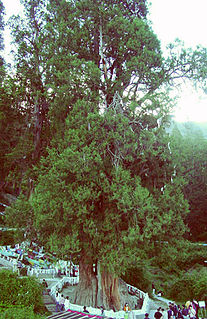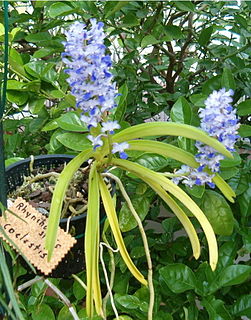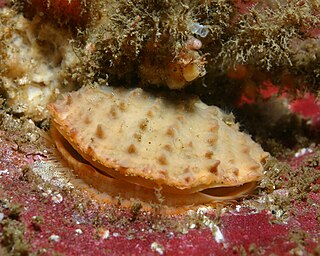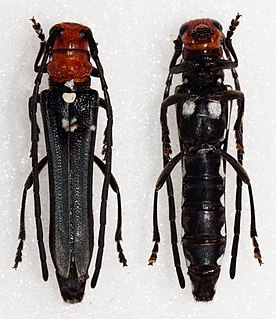Related Research Articles

The Aldabra giant tortoise is a species of tortoise endemic to the islands of the Aldabra Atoll in the Seychelles. It is one of the largest tortoises in the world. Historically, giant tortoises were found on many of the western Indian Ocean islands, as well as Madagascar, and the fossil record indicates giant tortoises once occurred on every continent and many islands with the exception of Australia and Antarctica. Many of the Indian Ocean species were thought to be driven to extinction by over-exploitation by European sailors, and they were all seemingly extinct by 1840 with the exception of the Aldabran giant tortoise on the island atoll of Aldabra. Although some remnant individuals of A. g. hololissa and A. g. arnoldi may remain in captivity, in recent times, these have all been reduced as subspecies of A. gigantea.

Scolopendra gigantea, also known as the Peruvian giant yellow-leg centipede or Amazonian giant centipede, is a centipede in the genus Scolopendra. It is the largest centipede species in the world, with a length exceeding 30 centimetres (12 in). It is found in various places throughout South America and the extreme south Caribbean, where it preys on a wide variety of animals, including other sizable arthropods, amphibians, mammals and reptiles.

Aldabrachelys is the recognised genus for the Seychelles and Madagascan radiations of giant tortoises, including the Aldabra giant tortoise.

Cupressus gigantea, the Tibetan cypress, is a species of conifer in the family Cupressaceae in Asia. C. gigantea was previously classified as a subspecies of Cupressus torulosa because of their similar morphological characteristics and close distribution, but have since been genetically distinguished as separate species.

Rhynchostylis is a genus in the orchid family (Orchidaceae), closely allied to the genus Vanda and comprising four currently accepted species native to the Indian Subcontinent, China, Indochina, Malaysia, Indonesia and the Philippines. The name consists of a compound of two Greek elements : rhynchos 'beak' and stylis 'column' – in reference to the very broad, fleshy column of the flower. The flowers are borne in dense racemes and are noted for their intense, spicy fragrance. Although lacking in pseudobulbs, the plants have leathery leaves that are drought-resistant. These orchids grow naturally in warm, moist, shaded tropical areas and will thrive in cultivation if given consistent warmth, uniform moisture and bright, but indirect light. Hobbyists wanting to grow them will need a warm, humid growing environment with gentle air movement. They can be grown in pots, but are better grown in baskets, owing to the extreme fleshiness of their roots. Their unusually fragrant blooms often appear in the slightly cooler winter months.

Solidago gigantea is a North American plant species in the sunflower family. Its common names include tall goldenrod and giant goldenrod, among others.

Crassadoma is a genus of rock scallops, marine bivalve molluscs in the family Pectinidae. It is monotypic, the only species being Crassadoma gigantea, the rock scallop, giant rock scallop or purple-hinge rock scallop. Although the small juveniles are free-swimming, they soon become sessile, and are cemented to the substrate. These scallops occur in the eastern Pacific Ocean.

Saperdini is a tribe of longhorn beetles of the subfamily Lamiinae.

Leuconitocris is a genus of longhorn beetles of the subfamily Lamiinae, containing the following species:
Gigantea may refer to:
The Wych Elm cultivar Ulmus glabra 'Gigantea' was listed as U. montana var. giganteaHort. by Kirchner (1864). An U. montana gigantea was distributed by the Späth nursery, Berlin, in the 1890s and early 1900s. It did not appear in Späth's 1903 catalogue. A specimen at Kew was judged by Henry to be "not distinct enough to deserve a special name". Both Späth and the Hesse Nursery of Weener, Germany, supplied it in the 1930s.
Leuconitocris microphthalma is a species of beetle in the family Cerambycidae. It was described by Stephan von Breuning in 1950, originally under the genus Nitocris. It is known from Sierra Leone and the Democratic Republic of the Congo.
Leuconitocris subjuvenca is a species of beetle in the family Cerambycidae. It was described by Stephan von Breuning in 1950.
Leuconitocris argyrostigma is a species of beetle in the family Cerambycidae. It was described by Per Olof Christopher Aurivillius in 1914.
Leuconitocris argenteovittata is a species of beetle in the family Cerambycidae. It was described by Per Olof Christopher Aurivillius in 1914.
Leuconitocris angustifrons is a species of beetle in the family Cerambycidae. It was described by Harold in 1878.
Leuconitocris buettneri is a species of beetle in the family Cerambycidae. It was described by Hermann Julius Kolbe in 1893.
Leuconitocris nigricornis is a species of beetle in the family Cerambycidae. It was described by Olivier in 1795, originally under the genus Necydalis. It is known from Tanzania, South Africa, the Central African Republic, Mozambique, Uganda, Malawi, and Zambia.
Leuconitocris schultzei is a species of beetle in the family Cerambycidae. It was described by Hintz in 1919.
Leuconitocris tibialis is a species of beetle in the family Cerambycidae. It was described by Kolbe in 1893, originally under the genus Nitocris. It contains the varietas Leuconitocris tibialis var. holoflava.
References
- ↑ BioLib.cz - Leuconitocris gigantea. Retrieved on 8 September 2014.